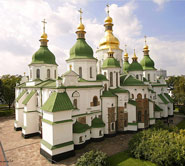Saint Sophia Cathedral
Built as the main temple of Rus metropolitan, Saint Sophia was social, political and cultural center of the state at that period. In the cathedral prince met ambassadors, chronics were written there, a first library was founded. Government held popular assemblies on a place in front of the cathedral.
In the period before Mongol invasion Saint Sophia was one of the biggest edifices in Kiev. It had 13 domes, covered with flat lead. At that time facades of churches were not plastered, they were decorated with dressings, ornaments, paintings.
In 1240 the cathedral was harried by nomadic tribes but fortunately not ruined. In 16 century it was in possession of Greek Catholics. In 17 century a monastery was founded there.
At the turn of the century 17, the cathedral was rebuilt in baroque style. Some changes happened in his appearance in 18 and 19 centuries.
In years 30 of 20th century, divine services are ceased in the temple and historical reserve is created there, which functions now. Random, in days of great religious and state holidays, solemn masses are held in the cathedral. In all the other time Saint Sophia meets guests. Thousands of visitors come every day to admire monumental art of ancient Rus, to observe original architectural forms kept inside from 11th century, to see carved inconstand of 18 th century and a complex of baroque edifices around the temple. Of a very great importance are frescoes and mosaics – wall paintings of Saint Sophia dated from 11th century. Unfortunately, only third part of ancient wall decorations is conserved – 260 m² of mosaics and 3 000 m² of frescoes. Other wall paintings from 17 and 18 centuries are of less value. Ancient Kiev Rus inscriptions, so called graffiti, scrabbled by something pointed, are seen on plastered walls of the church. Some of them contain the information about historical events and culture of ancient Kiev state. For example, there is an old slave alphabet that explains the origin of Cyrillic alphabet.
The founder of Saint Sophia cathedral – prince Yaroslav the Wise – is buried there. In the cathedral you can see miniature of Ancient Kiev and some permanently functioning expositions. In 1990, in view of unicity of Saint Sophia cathedral, it was taken under protection of UNESCO. The ancient ensemble of Saint Sophia is a museum that plays the part of Kiev and State symbol.

